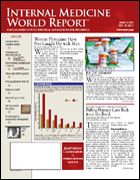Should You Recommend Dialysis for Very Elderly Patients?
Increasing Use in This Population Shows Dubious Results
The number of octogenarians and nonagenarians who were placed on dialysis for end-stage renal disease (ESRD) has nearly doubled over the past 7 years. But despite many changes in the characteristics of these patients over this time, the 1-year survival rate in this patient population has continued to hover around 50%, raising the question of whether using this modality in very ill people at a very old age is appropriate.
Ann Intern Med.
Investigators examined data from the US Renal Data System, which includes almost everyone who has started dialysis in the United States ( 2007; 146:177-183). The study population included 350,831 individuals aged ≥65 years who began dialysis between January 1, 1996, and December 31, 2003.
Very elderly patients were defined as those aged ≥80 years. Patients aged 65 to 79 years served as the control group.
Analysis showed an average annual increase of 9.8% in the use of dialysis for the very old. This trend applied to most subgroups, with similar increases seen in men and women and in whites and blacks (Table).
After adjusting for population growth, the rate of dialysis initiation between 1996 and 2003 increased by 57% in those aged ≥80 years.
Compared with the very elderly who started dialysis in 1996, those who started dialysis in 2003 had a higher glomerular filtration rate (GFR) and a lower incidence of chronic kidney disease–related morbidity.
Of note, 2 frequently cited reasons for beginning dialysis in the elderly—congestive heart failure and malnutrition—did not play a role in the tripling of dialysis initiation at a higher estimated GFR.
Other important findings include:
• The average annual increase in dialysis initiation was 8.6% for patients aged 80 to 84 and 11.9% for the oldest group (≥85 years)
• The corresponding average annual increases in population were 2.3% and 3.2%
• In contrast, the average annual increase in dialysis initiation was only 3.5% in the younger group (aged 65-79).
Survival after starting dialysis in the very old was poor and much lower than that of age-matched peers who did not start dialysis, with only 54% of patients living for 1 year.
The lack of a significant survival benefit highlights the importance of differentiating between elderly patients with life-shortening ESRD who could benefit clinically from dialysis and elderly patients in whom ESRD is but one manifestation of an underlying multiorgan dysfunction and thus would be more suited to palliative care.
Although realistic estimates of life expectancy play a role in the decision, patient preference and quality of life must also be considered. The authors recommend that primary care physicians begin discussing these issues early in the disease process so that elderly patients and their caregivers can have long-term care plans in place before dialysis becomes a possible option.
